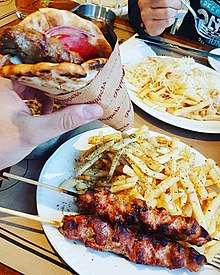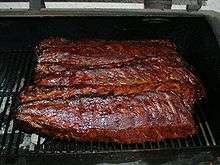Souvlaki
Souvlaki (Greek: σουβλάκι [suˈvlaci]), plural souvlakia, is a popular Greek fast food consisting of small pieces of meat and sometimes vegetables grilled on a skewer. It is usually eaten straight off the skewer while still hot. It can be served with pita bread, fried potatoes, lemon, and sauces, but the souvlaki itself is eaten on its own, with the side dishes eaten subsequently. The meat usually used in Greece and Cyprus is pork, although chicken, beef, and lamb may also be used. In other countries (and for tourists), souvlaki may be made with meats such as lamb, beef, chicken, and sometimes fish.
Souvlaki in Athens, known there also as kalamaki | |
| Type | Fast food |
|---|---|
| Place of origin | Greece |
| Associated national cuisine | Greece |
| Main ingredients | Various meats |
Etymology
The word souvlaki is a diminutive of the Medieval Greek souvla (σούβλα meaning "skewer") itself borrowed from Latin subula.[1][2] "Souvlaki" is the common term in Macedonia (Greece) and other regions of northern Greece, while in southern Greece and around Athens it is commonly known as kalamaki (καλαμάκι meaning "small reed").
History
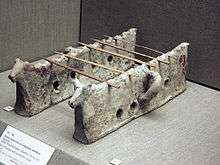
In Greek culture, the practice of cooking food on spits or skewers historically dates back to the Bronze Age.[3] Excavations in Santorini, Greece, unearthed sets of stone cooking supports used by the natives of the island before the Thera eruption of the 17th century BC; souvlaki was "a popular delicacy in Santorini back in 2000 BC."[4] In the stone cooking supports, there are pairs of indentations that were likely used for holding skewers and the line of holes in the base allowed the coals to be supplied with air.[5]
In Mycenaean Greece, "souvlaki trays" were discovered in Gla, Mycenae, and Pylos.[3] The "souvlaki trays" (or portable grills) used by the Mycenaean Greeks were rectangular ceramic pans that sat underneath skewers of meat.[3] It is not clear whether these trays would have been placed directly over a fire or if the pans would have held hot coals like a portable barbecue pit.[3][6] Spit supports appear to "continue in use into the Early Iron Age at Nichoria."[3] In Greek literature, Homer in the Iliad (1.465) mentions pieces of meat roasted on spits (ὀβελός); this is also mentioned in the works of Aristophanes,[7] Xenophon,[8] Aristotle,[9] and others.[10][11] In Classical Greece, a small spit or skewer was known as ὀβελίσκος (obeliskos),[12] and Aristophanes mentions such skewers being used to roast thrushes.[13]
In the Byzantine Empire, the Greek author of the Prodromic Poems (4.231) mentions "the hot meat shops" of Constantinople providing clients with spit-roasting meat slices similar to souvlaki known as psenasis souglitarea.[14]
Modern-day souvlaki was described by Gustave Flaubert, a French traveler, who observed Greeks "grilling pieces of meat on a bamboo stick" during his visit to the Boeotian countryside in 1850.[15] However, modern-day souvlaki was not widely distributed in Greece until after World War II.[15] Souvlaki skewers served as fast food started to be sold widely in the 1960s, after being introduced by vendors from Boeotia.[15] The first known use of the word souvlaki in English was in 1942.[16]
The issue of whether modern-day souvlaki skewers are a continuation of ancient Greek culinary traditions or came to Greece via Turkish cuisine and should be considered a Greek styling of shish kebab is a topic of sometimes heated debate, at least between Greeks and Turks.[17]
Variations
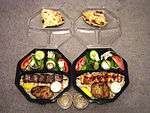
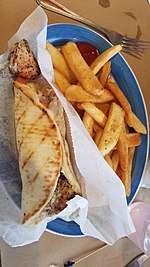
Kalamaki
Kalamaki (καλαμάκι meaning "small reed") is a synonym for souvlaki proper in Athens where the word souvlaki is used colloquially for any kind of pita wraps. Kalamaki can also be accompanied with vegetables such as tomato, peppers and onions and as a sauce with some lemon juice. There are some places in Greece where kalamaki is not connected in any way to souvlaki such as Thessaloniki; in these regions, souvlaki refers to the dish that in Athens is called kalamaki.
Souvlaki-merida
Merída (μερίδα) means portion in Greek. While souvlaki is eaten plain on hand as a fast food, it is also served as a full plate, served with fried potatoes, vegetables, sauce, and quartered pita bread. Usually it consists of the ingredients of a souvlaki-pita (see below) but laid out on a plate instead of wrapped together for eating on hand. Souvlaki can be combined with different bread, when it comes to meat, lamb is mostly used, ox also used by example.
Souvlaki pita
Pita is a form of partially leavened, flat, round bread with a diameter of approximately 15 cm (5.9 in), used to wrap souvlaki or gyros. It comes pre-baked and will additionally be grilled on the meat drippings just before serving, unless the customer requests it not to be. In Athens and southern Greece, it is called pita-kalamaki.
A souvlaki-pita consists of souvlaki meat garnished with sliced tomatoes and onions, fried potatoes, tzatziki, and wrapped in a lightly grilled pita. When chicken is used instead of pork meat, tzatziki and onions are replaced with a special yellow mustard sauce and lettuce to be compatible with its taste; various other garnishes and sauces are possible, including shredded lettuce, paprika, fried potatoes, ketchup, and mustard. Sauces like ktipiti, Russian salad or melitzanosalata can also be used as an extra option. Any of these components may not be included, at the request of the customer. Hungry customers may occasionally request a two-pita wrapping (diplopito) and/or a double meat serving (dikalamo).
Corfu
In Corfu, a special tomato sauce is added to souvlaki, plainly called "red sauce" (κόκκινη σάλτσα).
Cyprus
In Cyprus, souvlaki can refer both to the small chunks of meat on a skewer, and to the dish. It is made with a large pita that has a pocket-style opening. Into this is placed the meat (traditionally lamb or pork, more recently sheftalia or chicken), which in Cypriot souvlaki is cut into slightly larger chunks. Tomatoes, cucumbers and shredded white cabbage are the usual salad additions. Onion, parsley, and pickled green chili peppers are popular accompaniments, as are yogurt and tzatziki. Cut lemons are always included with souvlaki, as they are with all grilled meats in Cyprus. Lettuce is not traditional and is seldom used in souvlaki outside of tourist resorts.
See also
| Wikimedia Commons has media related to Souvlaki. |
- Doner kebab and its variants, including the Arab shawarma, Greek gyro, and Mexican al pastor.
- Kebab – Small pieces of meat and vegetables grilled on a skewer.
- Satay – Southeast Asian version of skewered meat.
- Shashlik – Middle-Eastern version of skewered meat.
- Tsukune – Japanese version of skewered meat.
References
Citations
- Georgios Babiniotis, Λεξικό της Νεας Ελληνικής Γλώσσας, s.v.; Andriotis et al., Λεξικό της Κοινής Νεοελληνικής, s.v. σουβλάκι, s.v. σούβλα
- Sophocles 2004, p. 1000.
- Hruby 2017, "Souvlaki trays", pp. 23–25.
- Eptakili, Tassoula (9 October 2015). "Prehistoric Gastronomy: Dietary habits of a long-lost era". Greece Is. Retrieved 21 February 2016.
- Utilitarian terracotta object, Museum of Cycladic Culture, Akrotiri excavation artifacts, Santorini, Cyclades, Hellas (Greece).
- Gannon, Megan (8 January 2014). "Ancient Greeks Used Portable Grills at Their Picnics". Live Science. Retrieved 5 February 2020.
- Aristophanes. Acharnians 1007, Clouds 178, Wasps 354, Birds 388, 672.
- Xenophon. Hellenica, HG3.3.7.
- Aristotle. Politics, 1324b19.
- Homer. Iliad, 1.465.
- Wright 1999, p. 333.
- Liddell & Scott 1940: ὀβελίσκος, diminutive of ὀβελός (obelos).
- Aristophanes. Acharnians, 1007.
- Dalby 2010, pp. 70, 225.
- Matalas & Yannakoulia 2000, p. 6 including footnote 8.
- "Souvlaki". Merriam-Webster. Retrieved 5 February 2020.
- Gold 2009, p. 323, footnote 34: "Greeks and Turks also battle over the similar dishes which the first call soublaki (> English souvlaki) and the second şiş kebabı (> English shish kebab), each claiming to be the originators."
Sources
- Bonanos, Christopher (2005). Gods, Heroes, and Philosophers: A Celebration of all Things Greek. New York: Citadel Press (Kensington Publishing Corp.). ISBN 9780806536811.CS1 maint: ref=harv (link)
- Dalby, Andrew (2010). Tastes of Byzantium. London and New York: I.B. Tauris & Co. Limited. ISBN 9781848851658.CS1 maint: ref=harv (link)
- Gold, David L. (2009). Studies in Etymology and Etiology With Emphasis on Germanic, Jewish, Romance and Slavic Languages. San Vincente de Raspeig: Universidad de Alicante. ISBN 9788479085179.CS1 maint: ref=harv (link)
- Hruby, Julie (2017). "3 Finding haute cuisine: Identifying shifts in food styles from cooking vessels". In Hruby, Julie; Trusty, Debra (eds.). From Cooking Vessels to Cultural Practices in the Late Bronze Age Aegean. Oxford and Philadelphia: Oxbow Books. pp. 15–26. ISBN 9781785706325.CS1 maint: ref=harv (link)
- Liddell, Henry George; Scott, Robert (1940). A Greek-English Lexicon. Oxford: Clarendon Press.CS1 maint: ref=harv (link)
- Matalas, Antonia-Leda; Yannakoulia, Mary (2000). "Greek Street Food Vending: An Old Habit Turned New". In Simopoulos, Artemis P.; Bhat, Ramesh Venkataramana (eds.). Street Foods. Basel (Switzerland): Karger. pp. 1‒24. ISBN 9783805569279.CS1 maint: ref=harv (link)
- Sophocles, Evangelinus Apostolides (2004) [1888]. Greek Lexicon of the Roman and Byzantine Periods (From B. C. 146 to A. D. 1100). Athens: Pelekanos Books. ISBN 9789604007257.CS1 maint: ref=harv (link)
- Wright, Clifford A. (1999). A Mediterranean Feast. New York: William Morrow. ISBN 9780688153052.CS1 maint: ref=harv (link)
External links
- "How to Cook Like a Mycenaean". Archaeology Magazine. Archaeological Institute of America. 9 January 2014. Retrieved 5 February 2020.
